- Home
- Publications et statistiques
- Publications
- Monthly Business Survey – Start of Augus...
The Banque de France publishes a range of monthly and quarterly economic surveys that provide a snapshot of the French economy in the form of business climate indicators and short-term forecasts.
According to the business leaders surveyed (approximately 8,500 companies and establishments questioned between 22 July and 5 August), activity in July continued to grow significantly in industry and construction, and more moderately in market services. In August, business leaders expect activity to remain on the rise in manufacturing and construction and to change little in services, but these expectations should be interpreted with greater caution this month due to the summer holidays. Order books are deemed to be slightly less depleted in industry, with the exception of aeronautics, and in construction, while remaining relatively weak.
Our monthly uncertainty indicator, based on a textual analysis of the comments made by the businesses surveyed, continued to decline in all three sectors, and more significantly in construction. It remained significantly higher in industry than in services and construction, reflecting the former sector’s greater exposure to international markets, particularly to US pricing policy.
Business leaders in the agri-food (wine industry), wood-paperprinting, chemicals, and capital goods sectors mentioned this more specifically.
Selling prices were deemed unchanged overall in all three sectors. Supply difficulties remained low overall, except in the aeronautics and automotive industries. Recruitment difficulties affected 18% of businesses, down one percentage point from last month.
Based on the survey results, together with other indicators, we estimate that GDP should continue to grow in the third quarter at a pace similar to that of the previous quarter (+0.3% according to INSEE’s initial estimate).
1. In July, activity continued to grow at a steady pace in industry and construction and at a more moderate pace in market services.
In July, activity in industry grew at a faster pace than what business leaders had expected the previous month, driven by the transport equipment and capital goods sectors, but it slowed in the agri-food industry (notably due to a shortage of CO2 used in the production of beverages, frozen products, etc.) and other industrial sectors. More specifically, activity picked up in the aeronautics and automotive sectors (better production rates thanks to smoother supply chains). It remained buoyant in machinery and equipment, electrical equipment, and computer, electronic, and optical products. In contrast, the apparel-textiles-footwear sector declined slightly once again, particularly for apparel (disappointing customer spending and sales).
CAPACITY UTILISATION RATE
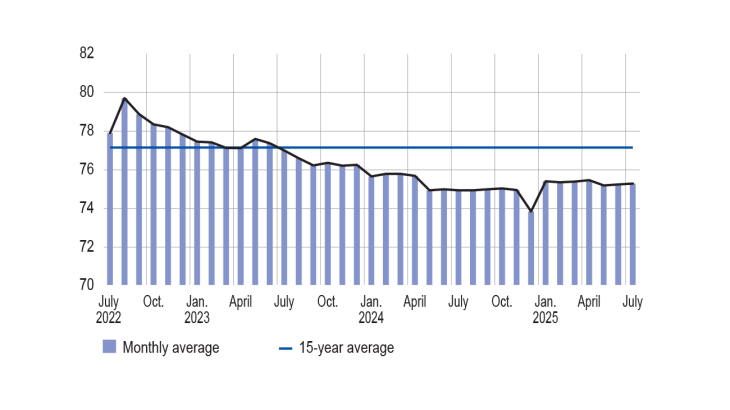
The capacity utilisation rate (CUR) for industry as a whole hardly changed, inching up to 75.3% (compared with 75.2%in June), well below its long-term average (77.2%). It rose in apparel-textiles-footwear (driven by the leather and footwear segment), computer, electronic and optical products (up 2 percentage points), and pharmaceuticals (up 1 percentage point). At the same time, it declined slightly in agri-food and other industrial products (down 1 percentage point).
BALANCE OF OPINION ON THE OUTLOOK FOR ACTIVITY
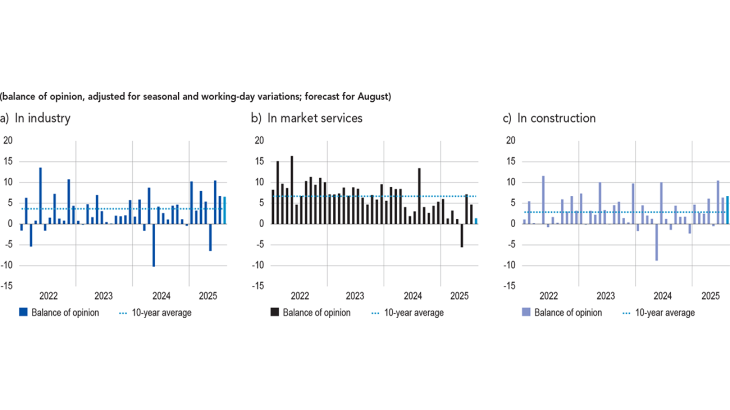
the past month) stood at 7 percentage points for July in industry. For August (light blue bar), business leaders in industry expect activity to increase by 7 percentage points.
Inventories of finished goods were stable at levels deemed high: the increase observed in aeronautics, wood-paperprinting, and machinery and equipment was offset by the decline in the chemicals sector and, to a lesser extent, in the agri-food and automotive sectors.
In market services, activity grew at a moderate pace overall, broadly in line with the expectations expressed by business leaders last month for July, albeit with considerable heterogeneity across subsectors. Activity rebounded in leisure and personal services and in food services (which were adversely affected by the heatwave in June). It picked up in the cleaning, legal and accounting, engineering, publishing and advertising sectors. It remained buoyant in transport-storage. However, it continued to decline in car rentals and information services and slowed in vehicle repairs and programming.
In construction, activity grew more strongly in July than what business leaders had expected in June, in both structural works and finishing works.
INVENTORIES OF FINISHED GOODS IN INDUSTRY
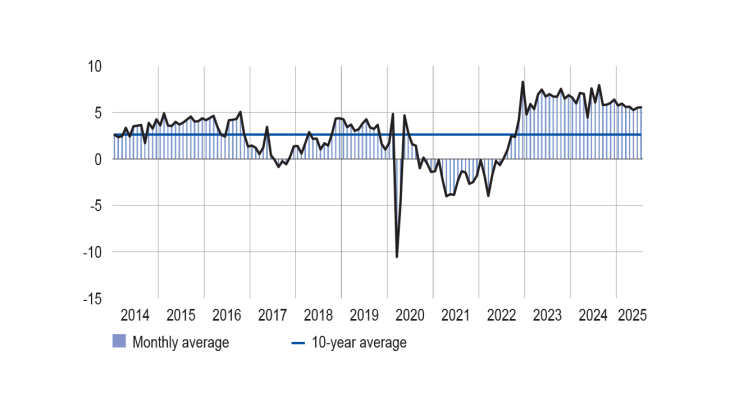
The balance of opinion on cash positions in industry improved and returned to slightly positive territory. It continued to improve in aeronautics and in computer, electronic and optical products, electrical equipment and pharmaceuticals. Conversely, it continued to decline in the “other industrial products” sector, the automotive industry, the metal and metal products sector and, to a lesser extent, in the woodpaper-printing and electrical equipment sectors.
However, this balance of opinion remained below its long-term average in all industrial sectors with the exception of aeronautics. It was particularly low in electrical equipment, chemicals, machinery and equipment, and rubber and plastic products. Business leaders mainly reported a trend toward longer customer payment terms.
In market services, the balance of opinion on the cash positions remained very slightly positive, although there was considerable heterogeneity across sub-sectors. The cash position was deemed very satisfactory in publishing and car rentals, and fairly satisfactory in temporary work, engineering, leisure activities and personal services. However, it is considered to have deteriorated in management consulting and food services.
CASH POSITION
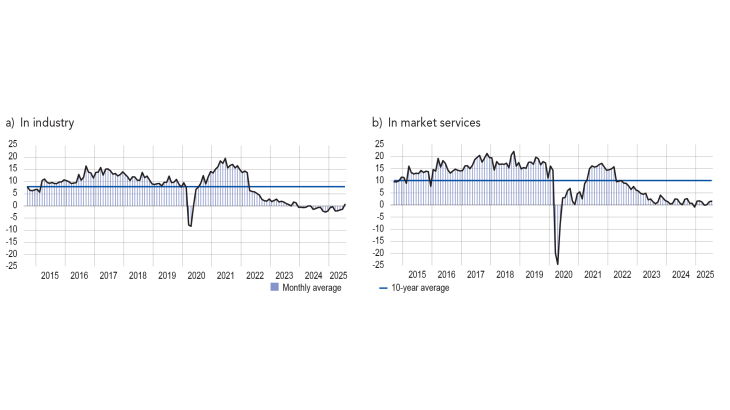
2. In August, business leaders expect activity to continue to grow in industry and construction, with little change in services.
In August, business leaders in industry expect activity to continue to grow at the same pace as in July, above its long-term average. It should be positive for most subsectors and strengthen in the “other industrial products” sector (particularly repair and maintenance activities), aeronautics, agri-food and pharmaceuticals. However, it should decrease- in wood-paper-printing, rubber and plastic products, and machinery and equipment.
In market services, activity in August is generally expected to change little, with considerable disparities across subsectors. It is expected to grow significantly in leisure activities, personal services, food services and most business services, particularly cleaning, information services and engineering. Conversely, it is expected to decline significantly in programming and temporary work. It should remain unchanged in accommodation and advertising.
Lastly, in construction, activity is expected to continue to grow in both structural works and finishing works, albeit at a slower pace for the latter.
However, all these forecasts for August should be interpreted with caution due to the impact of summer holidays on activity during this month (even though the data has been adjusted for seasonal variations).
LEVEL OF ORDER BOOKS
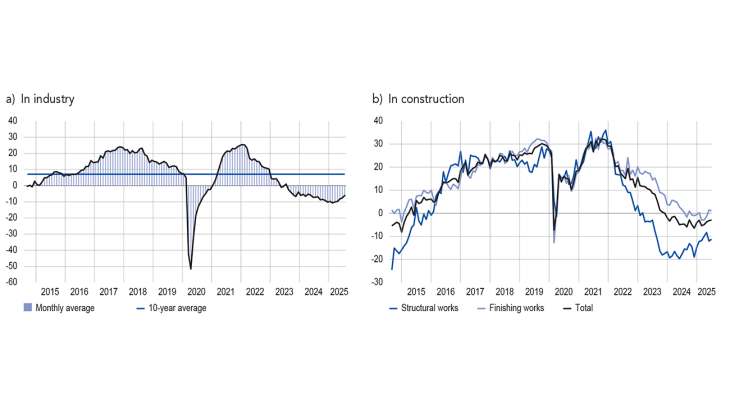
At the end of July, industrial order books were considered slightly less weak, although they were still well below their long-term average in all sectors except aeronautics, where they were very high. They were particularly low for rubber and plastic products (Chinese competition and a sluggish real estate market), wood-paper-printing, apparel-textilesfootwear, and chemicals. Business leaders reported a general wait-and-see attitude among customers.
In construction, the balance of opinion on order books was stable in the finishing works sector and recovered very slightly in the structural works sector, while remaining in negative territory. Business leaders mentioned the lack of public orders and visibility on the conditions for MaPrimeRénov’ aid for households.
Our monthly uncertainty indicator, which is constructed from a textual analysis of comments by businesses surveyed, continued to decline in all three sectors, and more significantly in construction, where it has reached its lowest level since the Covid period. The significantly higher level of our indicator in industry compared to services and construction reflects this sector’s greater exposure to international markets, particularly to uncertainties surrounding US tariffs. Business leaders in the agri-food (wine industry), wood-paper-printing, chemical, and capital goods sectors specifically mentioned this factor.
INDICATOR OF UNCERTAINTY IN THE COMMENTS SECTION OF THE MONTHLY BUSINESS SURVEY (MBS)
(unadjusted data)
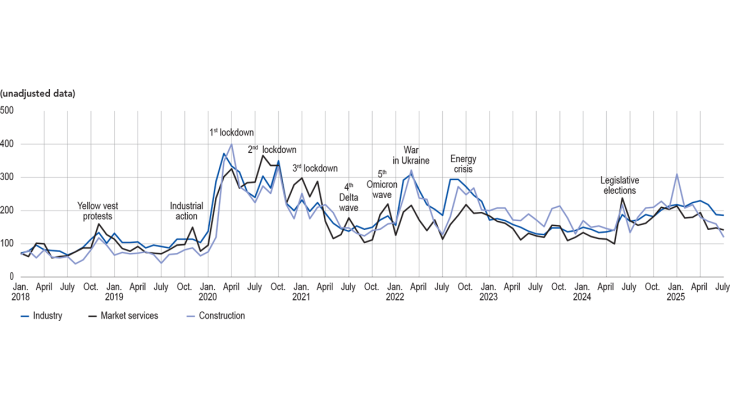
3. Selling prices were broadly unchanged
in all three sectors
In July, supply difficulties remained largely unchanged compared with the previous month (they were reported by 8% of companies, as in June). They were still relatively high in the automotive and aeronautics industries (they were reported by 22% of companies), although there is a downward trend in aeronautics compared with the levels observed at the beginning of the year. Supply difficulties in construction remained rare (3%).
In industry, raw material prices were deemed stable by business leaders. The increase observed in the agri-food, automotive and aeronautics industries was offset by the decline in the chemicals, wood-paper-printing and metal and metal products industries. The balance of opinion on finished goods’ prices1 was close to zero and down from June, with disparities across subsectors. It rose significantly in aeronautics and more moderately in apparel-textiles-footwear. Conversely, it dropped sharply in chemicals (reflecting the decline in raw material prices) and more moderately in agri-food.
CHANGE IN SELLING PRICES BY MAJOR SECTOR
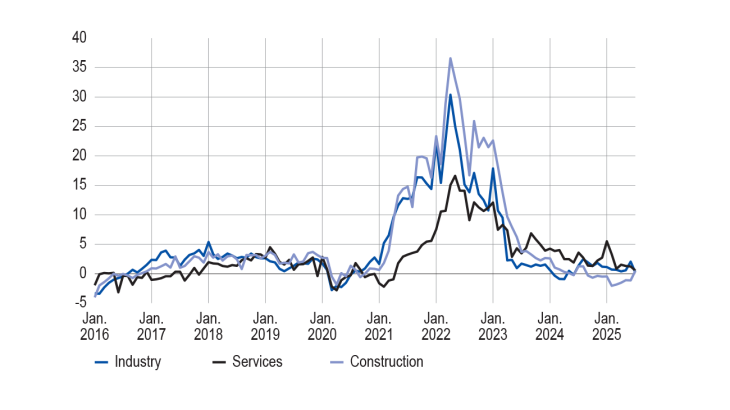
More specifically, 5% of business leaders in industry reported that they had raised their selling prices in July, which is lower than in July in previous years, including during the pre-Covid period. Price increases mainly concerned aeronautics (26%), wood-paper-printing (8%) and agri-food (7%). Conversely, 4% of business leaders in industry reported that they had lowered their selling prices, which is higher than the pre-Covid July figures. Price decreases for finished goods concerned the chemicals (17%), wood-paper-printing (7%) and metal and metal products (6%) subsectors.
In construction, the balance of opinion on price movements returned to slightly positive territory in July, in both finishing works and structural works for the first time in a year. 2% of business leaders reported increasing their quote prices, which was a lower proportion than that observed in July in previous years. In contrast, 10% of business leaders (8% in July 2024) reported lowering their quote prices, a much higher proportion than in July of previous years.
In market services, the balance of opinion declined and moved closer to zero. The share of businesses reporting price increases stood at 6%, slightly higher than pre-Covid July figures and well below the figures for 2021-23. Price increases mainly concerned accommodation and food services, cleaning, and car rentals. At the same time, the share of businesses reporting price decreases stood at 5%, which is higher than in July of previous years.
In July, 18% of business leaders reported recruitment difficulties, down one percentage point from June. These were still highest in construction and lowest in industry. Those in services were close to the overall average. In industry, staffing levels (including temporary workers) were deemed to be very slightly up.
SHARE OF BUSINESSES REPORTING RECRUITMENT DIFFICULTIES
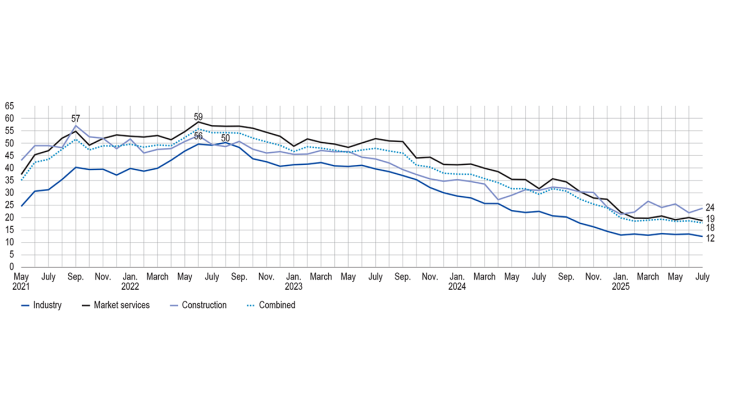
4. Our estimates suggest that GDP will continue to grow in the third quarter
According to quarterly account first results published by INSEE at the end of July, GDP growth stood at 0.3% in the second quarter of 2025 (after 0.1% in the first quarter), a significantly higher increase than we had forecast in our previous update on economic conditions (0.1%). Activity was mainly driven by strong growth in value added in market services, particularly in accommodation and food services and business services. Activity slowed in manufacturing and declined further in the energy sector. In construction, value added increased after two quarters of decline.
Based on the results of the Banque de France’s monthly business survey, supplemented by other available data (INSEE production indices and surveys and high-frequency data), we estimate that GDP should grow in the third quarter at a pace similar to that observed in the previous quarter. Activity is expected to be underpinned by strong growth in value added in manufacturing, as suggested by the monthly business survey. Value added is also expected to increase in market and non-market services, but to decline in construction and energy.
1The balance of opinion is the difference between the proportion of business leaders reporting increases or decreases, weighted by the intensity of the variation (with three possible grades in the monthly business survey: low, normal and high). A business leader indicating a “high” increase in prices will, all other things being equal, influence the balance of opinion more than a business leader indicating a “low” increase
Download the full publication
Updated on the 20th of August 2025